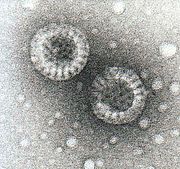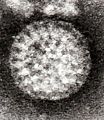Rotavirus facts for kids
Quick facts for kids Rotavirus |
|
|---|---|
 |
|
| Two rotaviruses | |
| Virus classification | |
| Group: |
Group III (dsRNA)
|
| Order: |
Unassigned
|
| Family: |
Reoviridae
|
| Subfamily: |
Sedoreovirinae
|
| Genus: |
Rotavirus
|
| Type species | |
| Rotavirus A |
|
| Species | |
|
Rotavirus A |
|
Rotavirus is a tiny virus that causes severe diarrhea (loose, watery poop). It also causes vomiting. Most of the time, children younger than five years old get this sickness. The signs of rotavirus infection, like sudden diarrhea and throwing up, usually last for two or three days. Rotavirus can also make animals sick. Good news: there's a vaccine that can stop children from getting this disease, and it's available in many countries.
Contents
What is Rotavirus?
Like most viruses, rotaviruses are made of RNA and protein. The RNA carries the instructions, called genes, to make more rotaviruses. These viruses are named "rotavirus" because they sometimes look like little wheels. "Rota" is the Latin word for "wheel."
How Rotavirus Spreads
Rotaviruses get into your body through your mouth. They are not in the air like cold viruses. The sickness often spreads when people don't wash their hands well. It can also spread through dirty cooking tools. Sometimes, the viruses can even get into water. Rotaviruses are super tiny. They are much smaller than bacteria and you can only see them with a special tool called an electron microscope.
How Rotavirus Affects Your Body
Rotaviruses infect the cells that line your small intestine. This makes it hard for your body to digest food properly. Children usually get completely better from a rotavirus infection. But it's super important to drink lots of water. This helps replace the fluids your body loses from diarrhea and vomiting.
In many places, doctors use a special drink called "oral rehydration solution." It comes in a small packet that you mix with drinking water. This solution has salt and sugar, which helps your body soak up the water better.
The Rotavirus Vaccine
Children who have not had the vaccine usually get infected more than once. But once children are about five years old, their bodies usually become strong enough to fight off the virus. This means they are "immune" and won't get sick from it anymore.
Rotaviruses were first found in the 1970s. Since then, doctors and scientists have learned that they cause problems for children all over the world. Many children used to get very sick or even die from rotavirus each year.
The Bill & Melinda Gates Foundation helps pay for rotavirus vaccines in countries that can't afford them. They have given a lot of money to help protect children from this sickness.
Images for kids
-
A simplified drawing of the rotavirus replication cycle. The stages are (1) attachment of the virus to the host cells, which is mediated by VP4 and VP7 (2) penetration of the cell by the virus and uncoating of the viral capsid (3) plus strand ssRNA synthesis ( this acts as the mRNA) synthesis, which is mediated by VP1, VP3 and VP2 (4) formation of the viroplasm, viral RNA packaging and minus strand RNA synthesis and formation of the double-layered virus particles (5) virus particle maturation and release of progeny virions.
See also
 In Spanish: Rotavirus para niños
In Spanish: Rotavirus para niños







